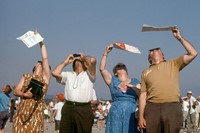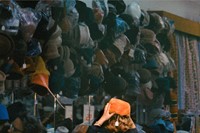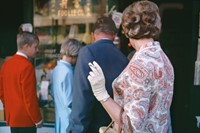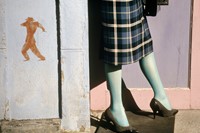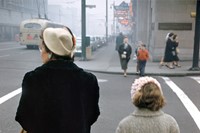A beautiful new book sheds light on one of colour photography’s lesser-known, but most extraordinary pioneers
“I wanted to show the world the way it is,” colour photography pioneer Fred Herzog once said. And that is just what he has spent more than half a century doing, obsessively documenting the streets of Vancouver – his home since 1953 – and those that populate it, with a wonderfully astute and technically skilled attentiveness. Long before his fellow Kodachrome devotees Stephen Shore and William Eggleston convinced the world of colour photography’s artistic gravitas, Herzog championed its virtues in his sumptuous portraits of city life, unaffected by the critical preference for black and white. (“Just as we know that liberty and fresh caught salmon are good, we knew then that colour was to be used only for pretty sights. Landscapes, swans, flowers, sunsets, gnarled trees and burning candles were okay. Everything else raised eyebrows,” he once noted sardonically.) Yet in spite of his vital contribution to the medium, it has only been in the past ten years that Herzog’s work has achieved the recognition it so clearly deserves and the photographer himself rightfully instated in the colour photography hall of fame. Now, a beautiful new book from Hatje Cantz allows us to take a retrospective look at Herzog’s observationalist oeuvre, alongside essays by the likes of David Campany and Jeff Wall.
Herzog was born Ulrich Herzog in 1930, near the city of Stuttgart in southern Germany. Tragically, his mother died when he was only 11 and his father passed away shortly after returning from the war, leaving the young Herzog to fend for himself. He worked for a brief period in a hardware store, buying his first camera at the age of 20 and cultivating his love of image-making in his spare time. In 1952 he emigrated to Canada in search of a job, arriving in Vancouver, by way of Montreal and Toronto, in May 1953, and working first on a cargo ship before taking up a position as a medical photographer at a hospital. This job, Campany notes in his essay for the book, “tethered him to the city, and to a very applied kind of photography”. Herzog described 1950s Vancouver as “engagingly seedy and colorful,” qualities that greatly appealed to his artistic sensibilities, and which he soon made it his mission to capture, embarking on regular trips to the city’s downtown sector, his newly purchased Leica 35mm in tow. “New, clean, safe and honest neighborhoods do not give rise to interesting pictures,” he said, in a telling statement of intent. “The thing that street photographers hope to discover has to do with the disorderly vitality of the street; the street people on the corners and plazas, in billiard parlours, pubs and stores, where shoppers, voyeurs and loiterers feel at home.”
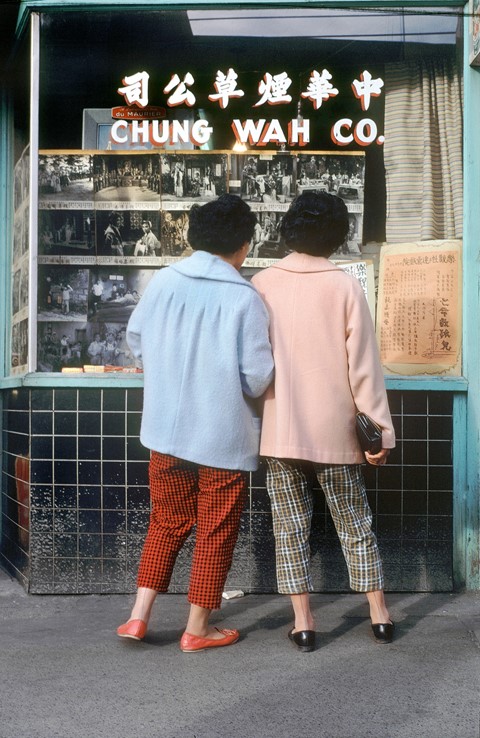
Shoppers, voyeurs and loiterers all appear at length in Herzog’s work, often captured from behind while window-browsing or road-crossing, or while engaged in an act of spectatorship – one of his most striking images titled Airshow (1968) depicts four figures shielding their eyes from the sun with paper leaflets as they gaze up, with animated pleasure, at the sky above them, while Fire, English Bay (1981) shows row upon row of rapt observers on a sandy shore staring at a vast apartment block engulfed by smoke and flames. Both images perfectly exemplify Herzog’s propensity for naturalistic framing and timing, qualities which invitingly coax viewers into his scenes. He also boasts a playful eye for complementary clothing combinations: Two Women in Coats sees said companions – arms interlinked and peering into a shop window in Chinatown – wearing precisely matching outfits (right down to the crop of their checked trousers) but in different colours. It is not just people that capture Herzog’s imagination, however: he has also taken many arresting photographs of the city itself, from buildings and billboards to window displays and cars, revelling in “the palette of postwar consumables, bright glossy paintwork as it weathers into muted hues, the subtleties of urban wood and stone, and the atmospheric variations of a coastal climate,” as Campany poetically summarises.
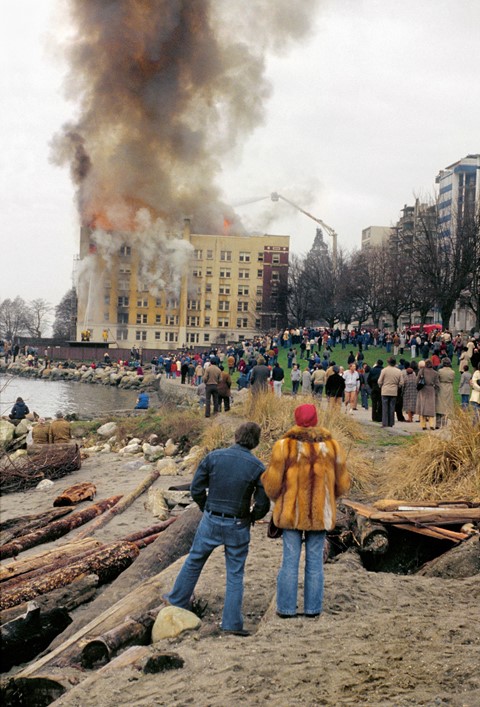
Over the course of his prolific career, Herzog has produced over 120,000 photographs all taken, in his words, to serve as “as a form of journalism”; to convey the evolution of a city as it grows and morphs and to commit the spirit of modern life to film as authors such as Gustave Flaubert and John Dos Passos (two of Herzog’s favourites) did with words on paper. After 50 years of image-making, a major retrospective in Vancouver in 2007 finally placed Herzog firmly on the colour photography map, allowing him the opportunity to restore many of his works using modern techniques, and happily opening up his impressive output to a wider audience. The photographer is remarkably modest and gracious about his late rise to fame, telling Time Magazine in 2011, “I didn’t step on anyone’s toes by coming late and having success.”

Fred Herzog: Modern Colour is out now, published by Hatje Cantz.

